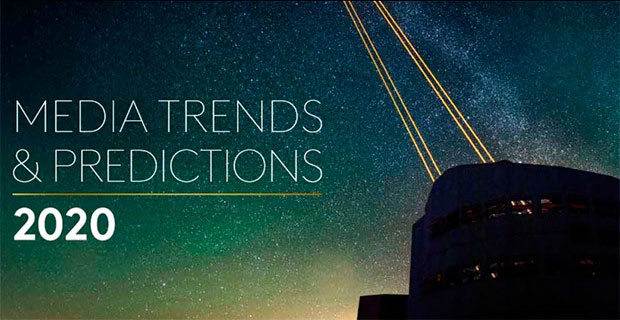
Technology will continue to redefine the media landscape in 2020, creating opportunities and challenges for marketers, according to Kantar’s Global 2020 Media Trends and Predictions which was published this week.
As ad spend on social and tech platforms continues to grow; technology innovations will also enable a renaissance in real-world engagement, Kantar says. It also notes that marketers and media owners will be challenged to develop the skills, engagement models and measurement capabilities to meaningfully engage consumers in the crowded media landscape.
Kantar predicts there will be a digital paradox; while new and evolving media channels will create opportunities, the deluge of digital touchpoints will make it more difficult to connect with consumers. Marketers will also need to navigate the ‘data dilemma,’ meeting consumer demand for relevant, personalised content, without breaching trust and privacy. And as third-party cookies start to crumble, advertisers will need to find alternative measurement solutions.
“It seems like we have been on the cusp of technology radically altering media for so long now, but that narrative will shift in 2020 as some of the challenges inherent with technology and greater digitisation come to the fore. Issues like greater data ethics, increasing data clutter and the move back to traditional brand building will be interesting to watch over the coming months,” says Mitchell O’Gorman, managing director, Kantar Ireland, Media Division.
Kantar’s 2020 Media Trends and Predictions fall into three major themes: the technology trends transforming the media landscape, the spaces that brands can credibly occupy and the context and catalysts for change.
In terms of the technology trends transforming the media landscape, Kantar singles out a number of things to watch including the following:
5G finally gets real: The marketing industry will be one of the key beneficiaries of the 5G era, enabling far greater capabilities to reach and engage with consumers but taking advantage of the 5G opportunity will require a significant transformation from marketers.
The battle of the streaming platforms heats up: New players will see the battle of the streaming platforms heat up, but an increasingly cluttered market will drive subscription fatigue among consumers.
Turning up the volume: Brands will turn up the volume and find their voice as we enter a new age of audio advertising. Newer audio channels are poised to gain mainstream prominence.
Content meets commerce: Content and commerce will converge as ‘shopvertising’ evolves from shoppable social to shoppable TV and digital out-of-home resulting in a contraction of the closed-loop marketing cycle.
In considering the spaces that brands can credibly occupy, Kantar makes a number of observations including:
Brands get back to reality: Brands will balance their digital presence with more real-world experiences, meaning we could see a slowdown in the pace of digital advertising growth.
Brands take a stand: Taking the lead from consumers, brands will become more radical in 2020. But they need to ensure their media strategy is aligned with their values and purpose.
Just grow up: influencer marketing must measure what matters: Influencer marketing will mature as brands start to collaborate more deeply and take measurement more seriously in 2020.
Get ready to play: esports goes mainstream: esports will go mainstream over the next 12 months, presenting lucrative opportunities for the media owners and advertisers that learn the rules of the game.
Finally, is assessing the context and catalysts for change, Kantar highlights a number of other things to take stock of including:
Turn and face the change: The trend towards media in-housing: The trend towards media in-housing will continue as more brands build their own teams of digital experts, pushing agencies and advertisers out of their traditional comfort zones, into a new collaborative and exciting space.
Cookies start to crumble: Changing the recipe: The demise of cookies could leave many marketers in the dark. Advertisers need to prepare now for the new “mixed economy”. Direct integrations between publishers and measurement partners will enable true cross-publisher measurement for the first time.
The data dilemma: Doing the right thing with data: Faced with impending legislation like the California Consumer Privacy Act in January 2020, privacy ethics will come to the fore and marketers will design personalisation initiatives with a people-first, rather than tech-first, mentality.
Campaign 2020: crowding and clutter: Political advertising will create crowding and clutter in 2020, especially in the U.S. media landscape. Brand advertisers will need to rethink their strategy during campaign season.




















